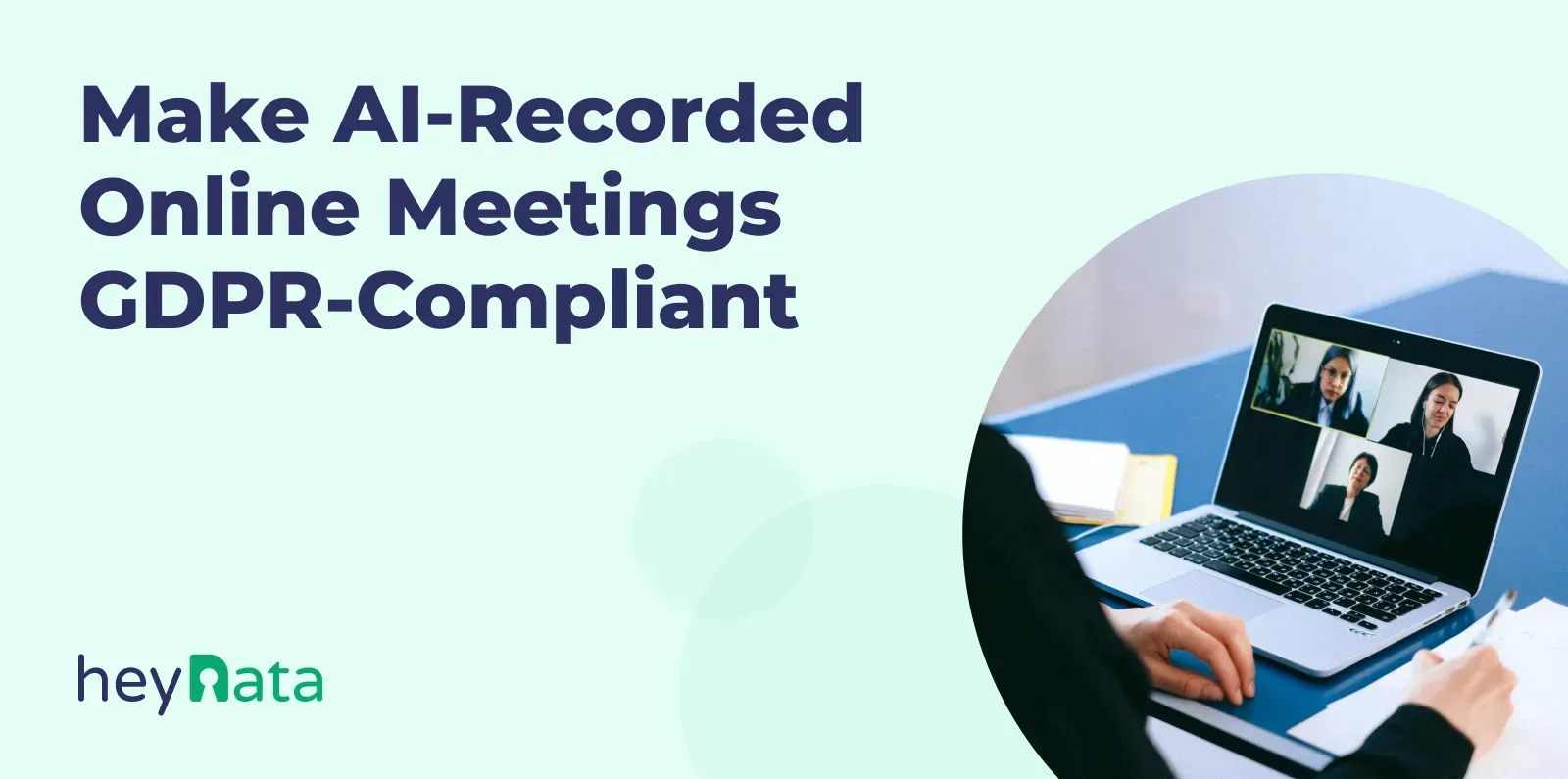
Balancing Trust and Control: How to Make AI-Recorded Online Meetings GDPR-Compliant

In today’s digital world, online meetings have become the default, whether in remote work setups or global collaboration. At the same time, AI tools that record, transcribe, and summarize conversations are booming.
The challenge? While these tools are becoming smarter, many data protection questions remain unanswered:
- When is recording legally allowed?
- What about the confidentiality of spoken words?
- How can companies build trust without creating a culture of surveillance?
Table of Contents:
AI-Powered Recordings – The New Standard?
Digital assistants that "listen in" during meetings are no longer rare. Tools like Otter.ai, Fireflies.ai, Zoom AI Companion, and Microsoft Copilot now routinely offer features such as:
- Real-time transcripts and meeting notes
- Action item summaries
- Sentiment and tone analysis
- Automatic follow-up emails
A real-world example:
A SaaS sales team uses an AI tool to transcribe customer calls and auto-generate CRM notes. Time saved – but:
Customers often don’t know they’re being recorded. Even internally, it’s unclear where the data is stored and who has access.
Conclusion: Productivity gains can backfire when communication is unclear and trust is lost.
Legal Requirements: When Are Online Meeting Recordings Allowed?
Two legal principles apply in the EU (and Germany in particular):
- Consent is required:
Online meetings may only be recorded if all participants give explicit consent in advance. - Information obligation:
Participants must be clearly informed about:- Why the meeting is being recorded
- How the data will be processed
- Where the data is stored
- How long it will be kept
→ Important: A simple banner like "This meeting is being recorded" does not fulfill the legal requirement. Consent must be active—via a click, written note, or verbal agreement at the start of the call.
Common pitfalls to avoid:
- No mention of the recording in the calendar invite
- Verbal notice without documented consent
- Stealth recording via transcription tools without informing participants
German Law: §201 StGB – Violation of the Confidentiality of the Spoken Word
Besides GDPR, German criminal law applies.
Under §201 of the German Criminal Code, secretly recording a private conversation is a criminal offense.
In simple terms:
- Any private or internal conversation recorded without consent is illegal
- “Private” means restricted to a closed group (e.g., a team meeting, job interview, or customer call)
Example:
An HR team records a job interview using an AI tool without asking for consent. This is not only a GDPR violation—it’s a criminal offense under German law.
AI in Meetings: Benefits Come with Risks
While AI offers efficiency, it also introduces serious risks—especially with sensitive data:
- Storage in non-EU clouds (e.g., US, India)
- Lack of transparency on how data is further processed or used to train models
- Automatic profiling via voice tone, mood, response speed, etc.
Specific risks:
- AI summaries may misrepresent what was said
- Sharing transcripts with non-participants may violate confidentiality laws
Transcripts: Convenient but Risky
Automatic transcription is useful—but potentially dangerous.
Why? Because:
- It creates a permanent written record of everything spoken
- It can be copied, forwarded, or misused within seconds
- It’s often stored in collaboration or CRM systems, visible to large teams
Think of a transcript like a screenshot of your entire meeting.
One wrong click, and it ends up in the wrong hands.
What Companies Should Do:
- Restrict access to transcripts based on roles
- Set automated deletion timelines (e.g., 30 days)
- Prevent AI “enhancement” or analysis of content without prior consent
Best Practices for GDPR-Compliant Online Meetings
Before the Meeting:
- Clearly mention recording in the calendar invite ("Recording planned – consent required")
- Choose GDPR-compliant tools (EU hosting, certified security, clear documentation)
- Collect consent beforehand or record verbal agreement at the start
During the Meeting:
- Be transparent: Who is recording? Why? Where is the data stored?
- Use visual indicators (e.g., a visible recording icon)
- Allow anonymous or opt-out participation where possible
After the Meeting:
- Limit access to authorized roles only
- Define and follow storage and deletion policies
- Use summaries instead of full transcripts when possible
- Keep audit logs for data access
Technology Matters: Choose the Right Tools
Not all platforms are created equal. Look for tools with:
- End-to-end encryption
- Granular access control
- GDPR-compliant storage in EU data centers
- Configurable recording features (consent-based)
Recommendations:
- Use tools like BigBlueButton (open source, EU-based)
- Or Zoom/Microsoft Teams with enhanced privacy settings
- When using US tools, ensure Standard Contractual Clauses (SCCs) and DPAs are in place
The Future: How AI Can Support Data Protection
AI isn’t just a risk—it can be part of the solution if used ethically. Future systems could:
- Detect unauthorized recordings in real time
- Enable privacy-by-default processing (e.g., metadata only)
- Generate automated transparency logs (who accessed what and when)
Properly designed, AI can strengthen trust by promoting responsible collaboration instead of covert surveillance.
Conclusion: Build a Culture of Trust with Clear Rules
AI in online meetings is here to stay. But trust won’t follow automatically—it must be earned.
To make meetings both effective and privacy-conscious, companies should focus on:
- Clear consent processes
- Thoughtful tool selection
- Strong technical safeguards
- An ethical data approach
Those who communicate transparently and act responsibly can harness the full potential of AI without compromising privacy or company culture.
Important: The content of this article is for informational purposes only and does not constitute legal advice. The information provided here is no substitute for personalized legal advice from a data protection officer or an attorney. We do not guarantee that the information provided is up to date, complete, or accurate. Any actions taken on the basis of the information contained in this article are at your own risk. We recommend that you always consult a data protection officer or an attorney with any legal questions or problems.


